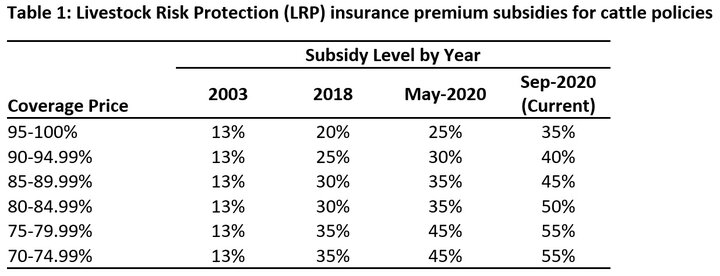After remaining relatively unchanged since inception in 2002, several enhancements and improvements to the Livestock Risk Protection (LRP) insurance program have taken place over the last 18 months. Several changes that affect the cattle industry took effect on January 20, 2021.
They include:
- Increasing the number of head of cattle that can be insured per endorsement and per year to 6,000 head and 12,000 head, respectfully.
- Modifying the ownership requirement window to be up to 60 days from the end of the endorsement period.
- Creating a new unborn feeder cattle type to allow for unborn calves to be insured.
The second and third changes listed above are particularly intriguing since previous regulations required the calves to be born and alive at the time the specific coverage endorsement was entered into and for ownership of those calves to be maintained until 30 days from the end of the endorsement period for the insurance to remain in force.
With the recent changes, producers can insure calves in February, for example, that will not be born until March or April. A check of the RMA website shows coverage available on January 20 for unborn steers & heifers for endorsement lengths from 13 weeks up to 43 weeks, with end dates ranging from April 21 to November 17, 2021. RMA assumes a 50/50 mix of steers and heifers. Therefore, the price coverage for unborn steers & heifers is an average of the price coverage available for steers weight 1 and heifers weight 1. The coverage rates are the same for all three.
Two earlier changes to LRP to be aware of include:
- Increasing subsidy levels for all coverage prices
- Allowing the premium to be due at the end of the coverage endorsement period rather than at the beginning
The previous and current premium subsidy rates for cattle are displayed in Table 1. Subsidy levels have dramatically improved in the past two years. Further, allowing the premium for LRP coverage to be due at the end of the coverage endorsement period rather than at the beginning reduces the financial and logistical burden on producers.

Example for LRP-Feeder Cattle
On January 20, LRP insurance coverage for feeder cattle was available for endorsement lengths up to 43-weeks with an end date of November 17, 2021. The expected ending value for Steers Weight 1 on that date was $167.64 per cwt. The expected ending value for Heifers Weight 1 on that date was $152.40 per cwt. Therefore, the expected ending value for Unborn Steers & Heifers on that date was $160.02 per cwt. (($167.64 + $152.40)/2). Insured at the highest coverage level of 0.9974, the coverage price for Unborn Steers & Heifers was $159.60. The unsubsidized rate of 0.064638 resulted in a total premium of $10.316 per cwt. With a 35 percent subsidy, this would be reduced to a producer premium of $6.705 per cwt. How effective this will be as a tool to mitigate downward price movements for 2021 is still to be determined. However, Table 2 shows how these same calculations would have worked in 2020.

LRP insurance is an important tool in the toolbox for livestock producers to use in managing national market price risk. In 2020, we saw national prices in mid-November that were 12 percent below expectations established back in January. With the $19.84 drop in the average steer and heifer price from $164.09 to $144.25, LRP insurance on unborn steers & heifers would have provided an indemnity of $13.88 mitigating approximately 70 percent of this price decline. It is not always going to work out this way but LRP insurance is one tool that can help mitigate the negative effects of these market price drops when they do occur. With the recent changes to LRP, producers can now put this coverage in place for their fall calf crop sooner than they ever could before with larger premium subsidies making it more affordable and with more flexibility at the end of the contract than in previous years.
For more information on LRP insurance visit https://www.rma.usda.gov/Policy-and-Procedure/Insurance-Plans/Livestock-Insurance-Plans or contact your local livestock insurance agent.
This material is based upon work supported by USDA/NIFA under Award Number 2018-70027-28586.
Interviews with the authors of BeefWatch newsletter articles become available throughout the month of publication and are accessible at https://go.unl.edu/podcast.
Topics covered:
Marketing & risk management, Marketing, budgets & management

